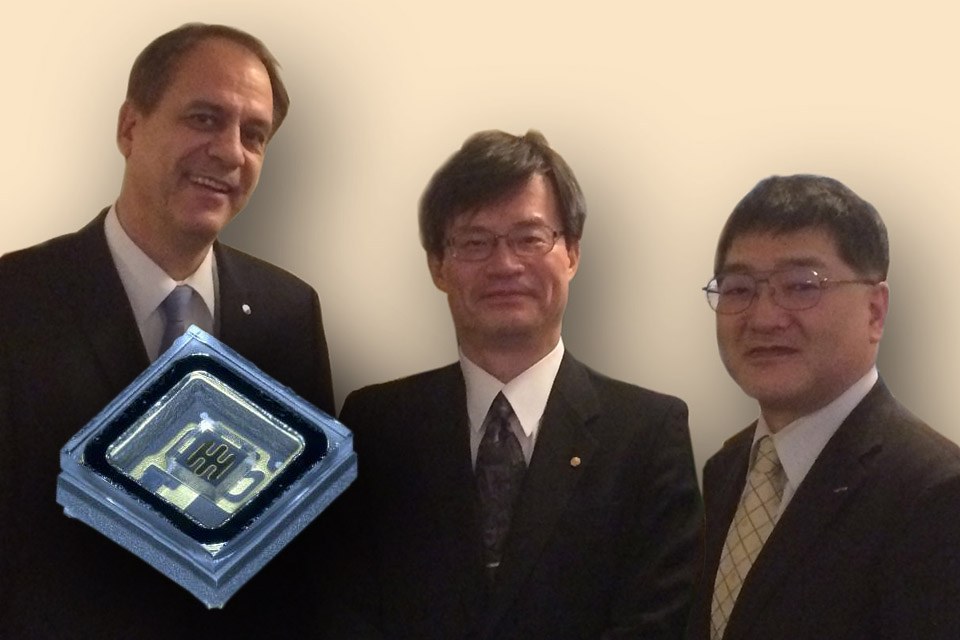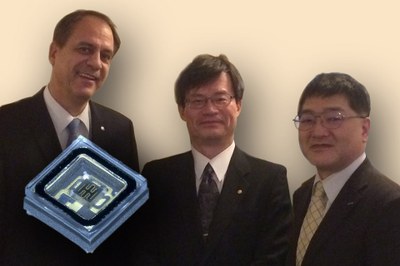Recipients of the Nobel Prize in Physics Support the Development of Deep-UV LEDs
Profs. Isamu Akasaki, Hiroshi Amano, and Shuji Nakamura received the Nobel Prize in physics in mid-December 2014 for their breakthrough that enabled the development of blue LEDs. In particular, Professor Amano and his team at Nagoya University have worked intensively over the past few years on further development of these semiconductor-based lamps. They provided consulting services to the Japanese firm of Nikkiso Co. Ltd. in the design of the first deep-ultraviolet light-emitting diodes (DUV-LEDs). These novel light sources cover wavelengths from 255 to 350 nm which were previously impossible to generate with LEDs. Fields of application include biotechnology, medicine, and environmental and industrial technology. The rights for marketing activities in Europe are held by Nikkiso subsidiary Lewa GmbH, who presented the technology for the first time in Europe together with Nikkiso at electronica 2014 in Munich.
The small and compact DUV-LEDs can be used for instance for photocatalysis and, therefore, for the decomposition of chemical materials. For medical purposes, the technical innovation could be used in phototherapy or immune therapy. Built into UV printers or for UV coating, the deep ultraviolet light would permit quick hardening of paint or lacquer resin. Even use in lithographical exposure and document verification would be possible. The novel UV-C LEDs could also be used for disinfection, water treatment, or sterilization in deactivation of bacteria and viruses in the life sciences area. For pump manufacturer and system integrator Lewa, applications in the field of online process monitoring technology are particularly relevant. "Our product presentation at electronica 2014 last November let us demonstrate once again the wide variety of possible applications," reports Dr. Hans-Joachim Johl, who handles the European marketing of DUV-LEDs at Lewa.
Single wavelengths from 255 to 350 nm:
DUV-LEDs from Nikkiso are the first LEDs manufactured under high quality requirements that emit deep ultraviolet light at single wavelengths from 350 nm down to the UV-C range at 255 nm. Wavelength emitters used until now, which will need to be withdrawn from the market in the near future due to their mercury content, require a comparatively high amount of electrical power, heat up, and have a limited life time due to frequent power cycles. They are also relatively large in size and the desired wavelength must be filtered out of the entire spectrum.
The LEDs developed in Japan are smaller and more compact than most UV-C light sources used today. The LED technology also does not heat its surroundings to the same extent. "Depending on the application, that can allow the distance between the lamp and the object can be reduced, so the entire device will be dimensioned smaller," explains Johl. Since the energy consumption is much lower for a higher light output, LEDs are more environmentally friendly – especially since they do not contain mercury. Other advantages are that the light is emitted immediately at the required wavelength and that the life time does not depend on the on and off switches of the lamp. The light intensity can be adapted to the specific applications by modifying the layout of the modules.
UV-LEDs will join the collection of the Nobel Museum:
Initial sales priority will focus on three models at wavelengths of 265, 285 and 300 nm. Depending on the potential, additional wavelengths and power outputs will be added to mass production. Lewa's goal is to integrate these LED modules into customer-specific applications – in particular in the fluids area. "There are many ways in process technology and analysis to combine LEDs with our core business. For example the new technology could be built into the Ecoprime chromatography systems for the absorptive concentration measurement of DNA/RNA and proteins or for sterilization," says Dr. Johl.
Special DUV-LEDs are built by Nikkiso for display in the Nobel Museum. This museum devoted to the life and work of Nobel Prize winners from 1901 to today and the life of founder Alfred Nobel. Due to the close collaboration, Dr. Hidemasa Tomozawa, Deputy General Manager from the UV-LED factory in Hakusan, Japan and Dr. Hans-Joachim Johl, Director of Global Business Development Pharma & Life Sciences at German subsidiary Lewa GmbH were able to accompany the professors to the Nobel Week events in Sweden.
For additional information, please visit www.lewa.de or contact lewa@lewa.de
About LEWA GmbH:
LEWA GmbH was founded in 1952 as a family company by Herbert Ott and Rudolf Schestag, and today is the world's leading manufacturer of metering and process diaphragm pumps as well as complete metering systems for process technology. The company, headquartered in Leonberg, Germany, has developed over just a few decades into an international group, and its position in the world market was further strengthened by its integration into the Japanese Nikkiso Co. Ltd. in 2009. As a researching and productive company, LEWA develops technologies and works out solutions for a wide variety of its customers' applications. Products are primarily used in the oil and gas industry, in the area of gas odorization, refineries, and petrochemistry, but also in the manufacture of plastics, detergents, and cleaning agents. Additional application areas can be found in chemistry, the cosmetics industry, in pharmaceutical and biotechnology, in the food and beverage sector, and in power supply. LEWA currently has approximately 1000 employees and has 16 subsidiaries worldwide as well as representatives and sales offices in over 80 countries.


